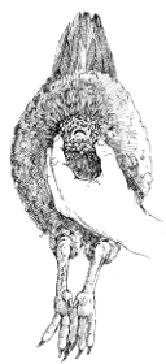Agriculture Reference
In-Depth Information
A crusty, infected-looking vent area indicates vent gleet.
Weather, Handling, and Diet-Related Conditions
Extreme cold or heat can cause poultry a great number of health problems. Cold is par-
ticularly destructive as the stressed body of cold birds may result in frozen body parts
which causes
gangrene
when the tissues thaw, die, and begin to rot.
Frostbite
Frostbite is best controlled by being proactive and not allowing a bird to suffer the con-
dition. Providing the birds with an adequate, draft-free building, especially in winter,
keeps birds frostbite-free. Waterfowl rarely get frostbite; just keep their wet little bodies
away from the drier types of fowl.
Frozen Combs and Wattles
Those of us who have poultry in regions with subzero temperatures deal with the prob-
lem of frozen bird body parts perennially. Numerous breeds handle the cold better than
sulated or heated facility to winter over the birds.
At just what temperature the damage starts to occur depends on the condition of the
birds and the condition of the facilities, taking into account such things as draftiness and

